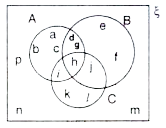Prove the distributive law and De Morgan's law.
(i) A∩(B∪C)=(A∩B)∪(A∩C)
(ii) (A∪B)'=A'∩B'
Step-by-Step Solution
1. Assume an element x: Let x be an arbitrary element such that x∈A∩(B∪C).
2. Apply the definition of intersection and union: Since x∈A∩(B∪C), it follows that:
- x∈A (from the intersection)
- x∈(B∪C) (from the intersection)
3. Apply the definition of union: The statement x∈(B∪C) means:
- x∈B or x∈C
4. Consider both cases:
- Case 1: If x∈B, then x∈A and x∈B implies x∈(A∩B).
- Case 2: If x∈C, then x∈A and x∈C implies x∈(A∩C).
5. Combine the cases: Therefore, in either case, we have:
- x∈(A∩B) or x∈(A∩C)
6. Conclude the proof: This means:
x∈(A∩B)∪(A∩C)
Thus, we have shown that:
A∩(B∪C)⊆(A∩B)∪(A∩C)
7. Reverse inclusion: Now we need to show the reverse inclusion:
- Assume x∈(A∩B)∪(A∩C).
- Then x∈(A∩B) or x∈(A∩C).
8. Analyze both cases again:
- Case 1: If x∈(A∩B), then x∈A and x∈B.
- Case 2: If x∈(A∩C), then x∈A and x∈C.
9. Combine both cases: In either case, since x∈A and either x∈B or x∈C, we have:
- x∈A and x∈(B∪C)
10. Conclude the proof: Thus, x∈A∩(B∪C). Therefore:
(A∩B)∪(A∩C)⊆A∩(B∪C)
11. Final conclusion: Since both inclusions hold, we conclude:
A∩(B∪C)=(A∩B)∪(A∩C)
Part (ii): Proving De Morgan's Law
We need to prove that:
(A∪B)′=A′∩B′
1. Assume an element x: Let x be an arbitrary element such that x∈(A∪B)′.
2. Apply the definition of complement: The statement x∈(A∪B)′ means:
- x∉(A∪B)
3. Apply the definition of union: The statement x∉(A∪B) means:
- x∉A and x∉B
4. Apply the definition of complement: Thus, we can write:
- x∈A′ (since x∉A)
- x∈B′ (since x∉B)
5. Combine the results: Therefore, we have:
- x∈A′ and x∈B′
6. Conclude the proof: This means:
x∈A′∩B′
Thus, we have shown that:
(A∪B)′⊆A′∩B′
7. Reverse inclusion: Now we need to show the reverse inclusion:
- Assume x∈A′∩B′.
- Then x∈A′ and x∈B′.
8. Analyze both conditions: This means:
- x∉A
- x∉B
9. Combine the results: Therefore:
- x∉(A∪B)
10. Conclude the proof: Thus, x∈(A∪B)′. Therefore:
A′∩B′⊆(A∪B)′
11. Final conclusion: Since both inclusions hold, we conclude:
(A∪B)′=A′∩B′
- x∈A (from the intersection)
- x∈(B∪C) (from the intersection)
- x∈B or x∈C
- Case 1: If x∈B, then x∈A and x∈B implies x∈(A∩B).
- Case 2: If x∈C, then x∈A and x∈C implies x∈(A∩C).
- x∈(A∩B) or x∈(A∩C)
x∈(A∩B)∪(A∩C)
Thus, we have shown that:
A∩(B∪C)⊆(A∩B)∪(A∩C)
- Assume x∈(A∩B)∪(A∩C).
- Then x∈(A∩B) or x∈(A∩C).
- Case 1: If x∈(A∩B), then x∈A and x∈B.
- Case 2: If x∈(A∩C), then x∈A and x∈C.
- x∈A and x∈(B∪C)
(A∩B)∪(A∩C)⊆A∩(B∪C)
A∩(B∪C)=(A∩B)∪(A∩C)
(A∪B)′=A′∩B′
- x∉(A∪B)
- x∉A and x∉B
- x∈A′ (since x∉A)
- x∈B′ (since x∉B)
- x∈A′ and x∈B′
x∈A′∩B′
Thus, we have shown that:
(A∪B)′⊆A′∩B′
- Assume x∈A′∩B′.
- Then x∈A′ and x∈B′.
- x∉A
- x∉B
- x∉(A∪B)
A′∩B′⊆(A∪B)′
(A∪B)′=A′∩B′
Topper's Solved these Questions
- BOOK - AAKASH INSTITUTE ENGLISHCHAPTER - SETS EXERCISE - Try yourself50videos
SETS
- BOOK - AAKASH INSTITUTE ENGLISHCHAPTER - SETS EXERCISE - SECTION-A(Objective Type Questions (One option is correct))41videos
SETS
- BOOK - AAKASH INSTITUTE ENGLISHCHAPTER - SETS EXERCISE - SECTION-I(Aakash Challengers Questions)4videos
SETS
- BOOK - AAKASH INSTITUTE ENGLISHCHAPTER - SEQUENCES AND SERIES EXERCISE - Assignment (SECTION - J) Aakash Challengers11videos
SEQUENCES AND SERIES
- BOOK - AAKASH INSTITUTE ENGLISHCHAPTER - STATISTICSEXERCISE - Section-C Assertion-Reason15videos
STATISTICS
Similar Questions
Prove A∪(B∩C)=(A∪B)∩(A∪C)
View SolutionProve (A∩B)'=(A'∪B')
View SolutionFor sets (A∪B)∪(A∩B)equals
View SolutionThe value of (A∪B∪C)∩(A∩BC∩CC)∩CC is
View SolutionIf A={x∈W:5<x<10},B={3,4,5,6,7} and C={x=2n,n∈N and n≤4}. Find:
(i) A∩(B∪C), (ii) (B∪A)∩(B∪C)
(iii) B∪(A∩C), (iv) (A∩B)∪(A∩C)
Name the sets which are equal.View SolutionGiven A={x∈N:x<6},B={3,6,9} and C={x∈N:2x−5≤8}. Show that:
(i) A∪(B∩C)=(A∪B)∩(A∪C)
(ii) A∩(B∪C)=(A∩B)∪(A∩C)View SolutionIf A = {5, 6, 7, 8, 9}, B={x:3<x<8 and x∈W} and C={x:x≤5 and x∈N}. Find :
(i) A∪B and (A∪B)∪C
(ii) B∪C and A∪(B∪C)
(iii) A∩B and (A∩B)∩C
(iv) B∩C and A∩(B∩C)
Is (A∪B)∪C=A∪(B∪C)?
Is (A∩B)∩C)=A∩(B∩C)?View SolutionIf A{1,2,3},B={3,4}andC={4,5,6}, then find the each of the following :
(i) A∩(B∪C)
(ii) (A−B)∪C
(iii) (A∪B)−C
(iv) (A∩B)∪C.View SolutionUse the given diagram to find:
(i) A∪(B∩C)
(ii) B−(A−C)
(iii) A-B
(iv) A∩B'
is A∩B'=A−B?
 View Solution
View SolutionFor any two sets A and B, prove that :
(i) A−(A−B)=A∩B
(ii) A∩(A'∪B)=A∩B.View Solution

